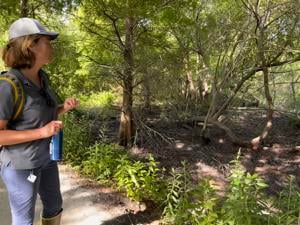SULLIVAN'S ISLAND — The maritime forest on this barrier island is a lush oasis that offers shade and protection, but invasive trees and grasses have taken root, creating issues for the native wildlife. These invaders will likely be removed in an effort to preserve the health of the maritime forest. How they will be taken — through herbicides or by hands and tools — is still to be decided.
At Station 16, a nature path runs through the forest on Sullivan's Island. Before the daytime heat sets in on June 19, the town's Director of Resilience and Natural Resource Management Rebecca Fanning points out a willow tree, bald cypress and the fragrant leaves of a wax myrtle along the trail. Story continues below Then she spots an invasive Chinese tallow tree, one of many that has planted its roots here.

Bright green, heart-shaped leaves that turn a vibrant red in the fall are its telling features. Its seeds are oily and its nectar is plentiful, making it enticing for adult birds. To the untrained eye, it seems like just another tree at home in the maritime forest.
Below the surface is where the trouble lies. That's where its roots drill deep toward the groundwater, sucking it up. "It causes a lot of problems for hydrology," Fanning said.
"It can totally dry out a wetland and in times of drought that ends up killing, potentially, the willows or the bald cypresses of this world." A host of other invasive plants, like the pampas grass and the wisteria plant use up the resources nativ.
















